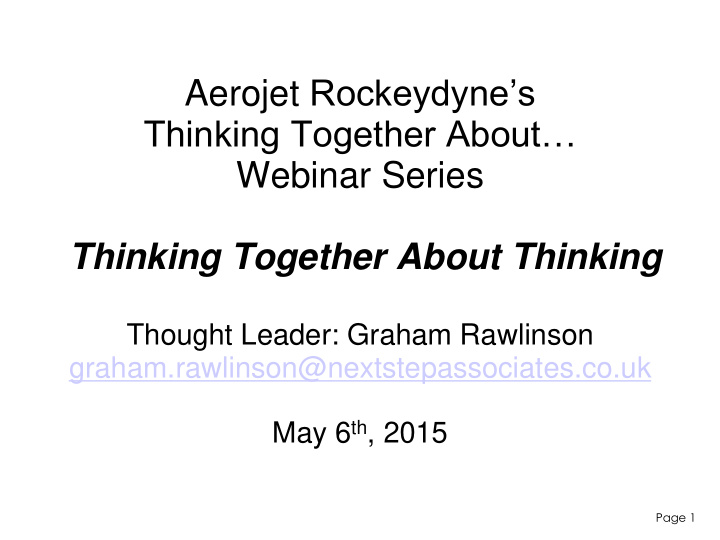



Aerojet Rockeydyne’s Thinking Together About… Webinar Series Thinking Together About Thinking Thought Leader: Graham Rawlinson graham.rawlinson@nextstepassociates.co.uk May 6 th , 2015 Page 1
Risk Management and the subconscious mind Freud said the subconscious was mostly about sex, but maybe sex is also risk management. In this talk, I want to suggest that we should consider how we are deluded into thinking we make decisions related to some future benefit, when in reality our subconscious is guiding us with its risk management subculture.
Nepal and Laos My personal history, and books on thinking about thinking
6 levels of poverty For most people in the world $200 a month would rank as poor I think. That's $4 a day. And this is the income of only a few better off Nepali men. And, on that income you have to probably feed and shelter and pat for education for grandparents, wife, and however many kids you have. So per person you are living off maybe 75c per person per day.
Level 1 Sheer survival, no real income, charity existence, future risk is unmanageble because only survival counts, all risks acceptable, but mostly you fail to have any optimism, time and effort are not worth investing as outcomes are too poor. People avoid you, you avoid people.
Level 2 Minimal and highly variable income. Precarious existence. No assets as no trust network except that of equally poor people, no physical assets of any quality (e.g. bicycle with no tyres but can be wheeled around with a load), no faith in any investment, investment tends to lead to loss as social network takes from anyone who gains assets (shared misery policy, but also shared survival).
Level 2 - continued Maybe you have to share with others as if not then one bad turn and down you go to level 1. No one helps you at level 1 and mostly you cease to help yourself! When drink and drugs added this level is disaster.
Level 3 $15 to $30 per month income, minimal assets as network, trust, contracts or physical assets. Freely available items mostly used in any trading (things thrown away by other people, but regular things not just lucky finds). Almost no risks taken. Operate on a maybe get lucky policy - via informal network or just cheap lottery tickets! This level is manageble or not depending on what comes free in the environment, too cold? Too hot? Some free local food? Can sleep anywhere? This is where free assets make a big difference.
Level 4 ($30 to 60 per month income) Investment will be minimal, expectations low, most income provides a base line living and not much more, motivation is low, fear is high, one level drop is now very serious indeed. Assets tend to be local knowledge and local informal contracts, habits, buying, selling renting. Minimal saleable assets.
Level 5 ($60 to 100 per month income) Investment has to be highly targeted, single strand, if nothing seems available then no investment made. Some saleable assets but minimal value.
Level 6 ($200 per month income) Investment levels are calculated, spread, high risk avoided except for minimal investment, most investment would be long term and carefully monitored. High risk is dangerous if it could drop you down even one level.
Level 6 - continued Maintain position if at all possible, be aware that without investment dropping down a level will naturally occur through accident and general degradation of assets, e.g. people. Some salable assets are accumulating but generally biggest asset is network, trust (based on knowledge of stable income). This is the first fairly safe level if managed well.
Company Risk Management It may be on some level of wealth not poverty, but does it behave like it is at one of these levels of poverty? And whereas most of the people at these levels of poverty are only attacked for what they have in a graded way (more money more attacks) companies can be attacked at all levels of wealth and poverty.
Do you make decisions? ● In previous talks I have suggested that we have very little control over our decisions. ● I have now come to believe that a big part of that is our ever present sense of managing risk ● BUT THIS IS SUBCONSCIOUS!
Self control? ● To have self control we must have self awareness ● And that includes being aware of our own sense of risk, how near or how far we FEEL from danger ● Social dangers ● Survival dangers ● And how we feel opportunity brings risk!
Recommend
More recommend